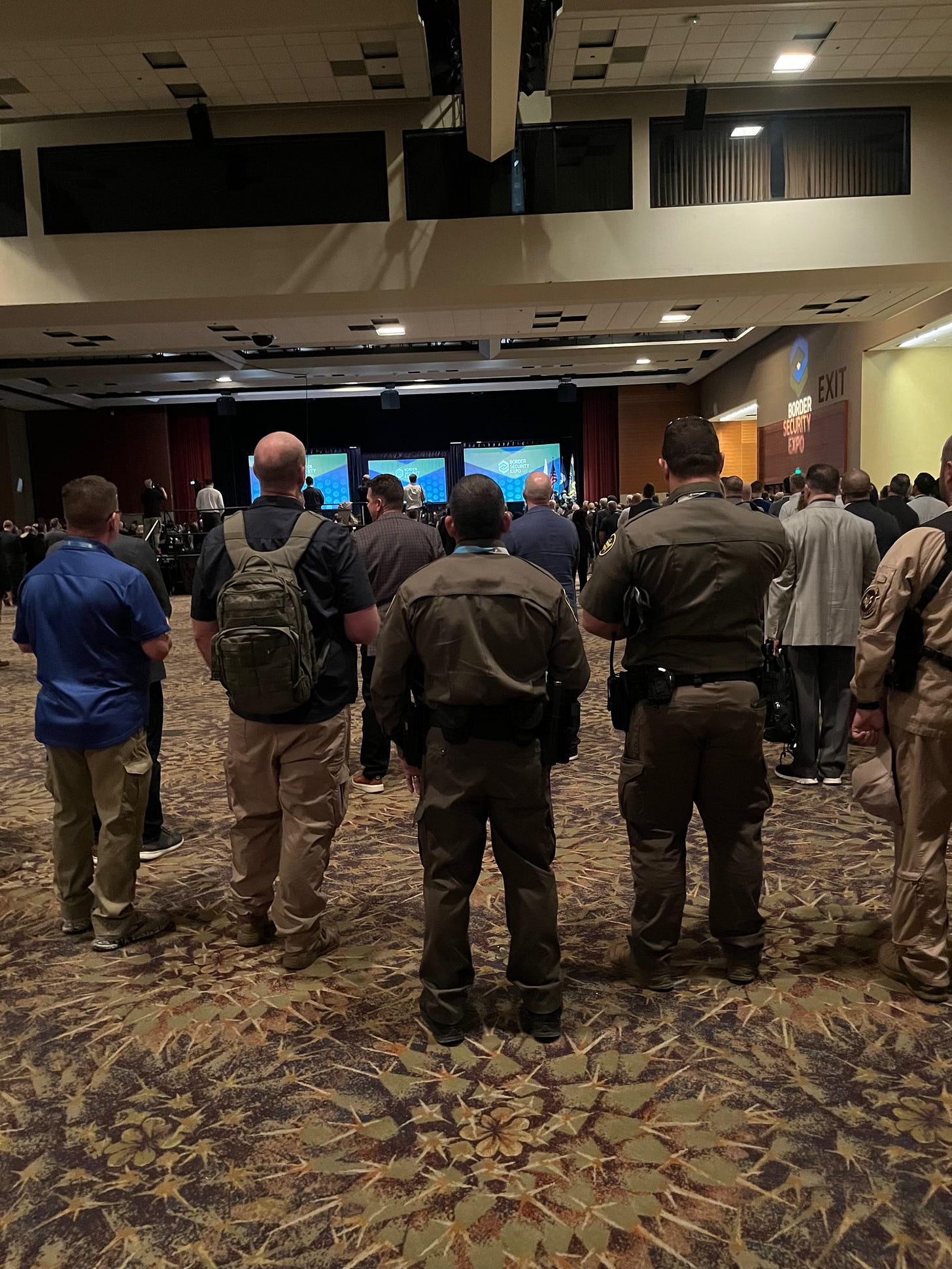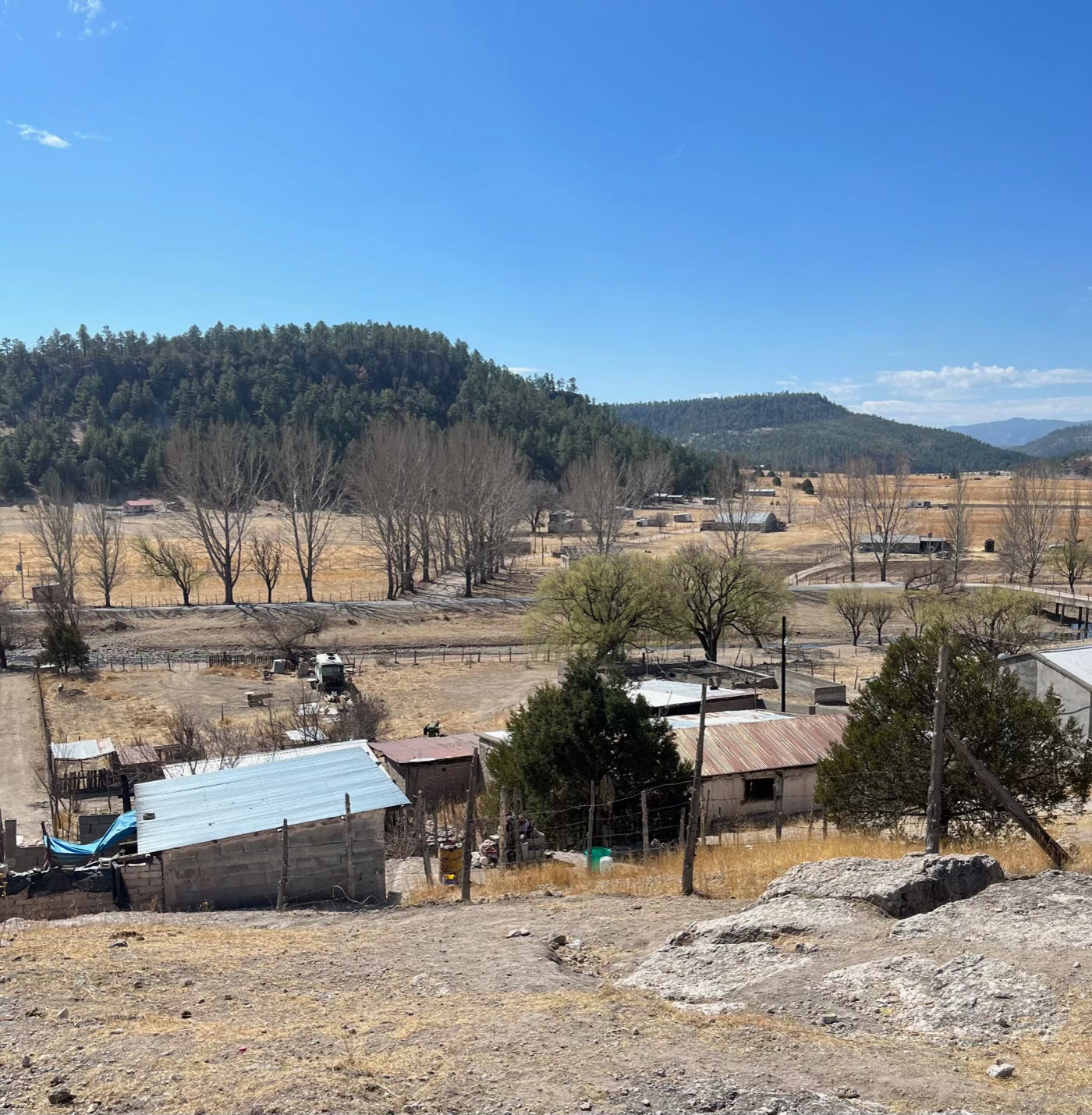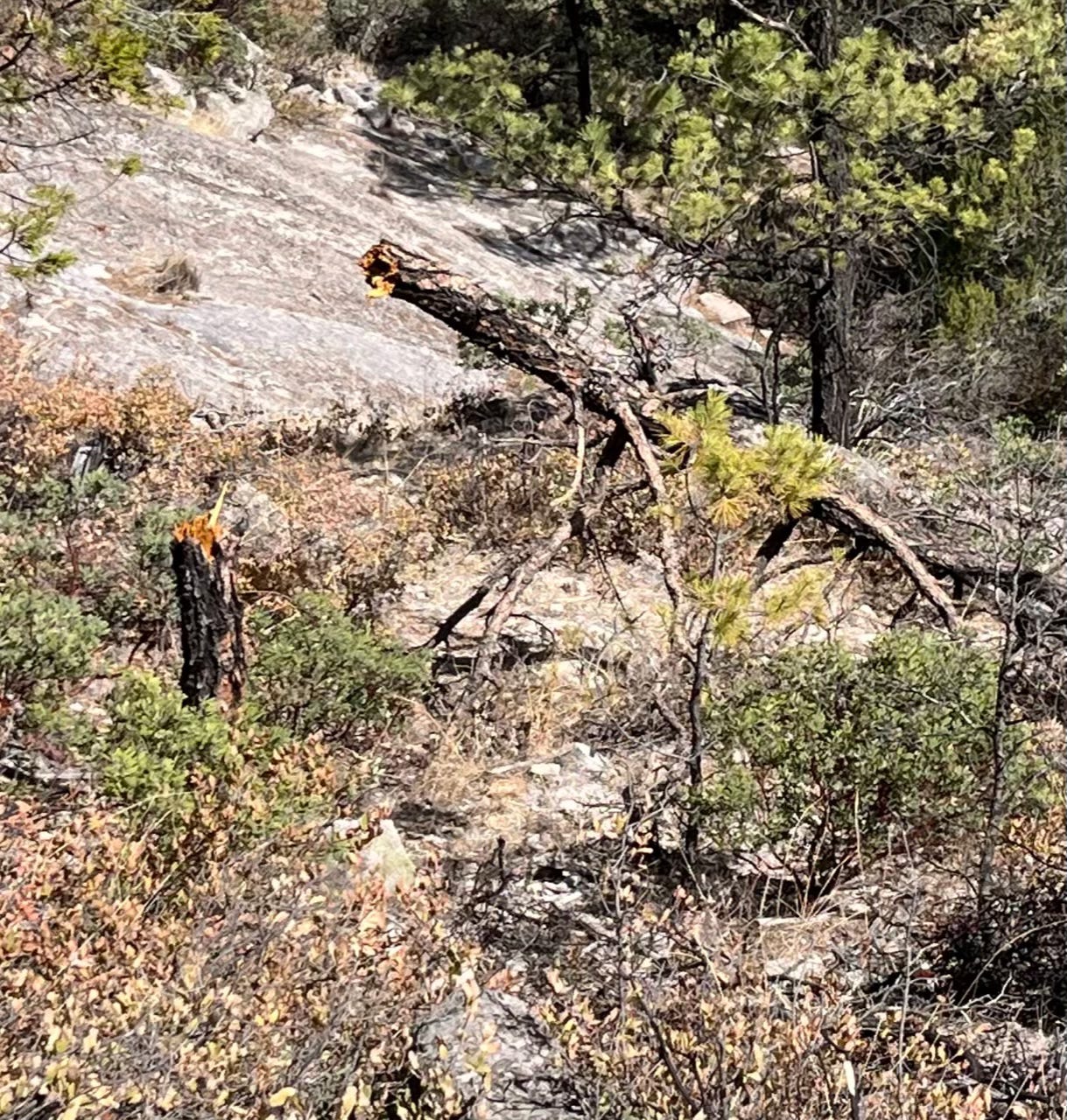Nota del editor: El siguiente artículo fue publicado originalmente por Todd Miller en el Border Chronicle el 3 de junio de 2025.
Lo crea o no, tuve una experiencia trascendental en la Exposición sobre seguridad fronteriza, el acontecimiento anual que reúne al Servicio de Aduanas y Protección de Fronteras (CBP) y al Servicio de Inmigración y Control de Aduanas (ICE) con la industria privada. No me atrevo a describirlo así, porque cuando estaba en la sala de exposiciones me encontré de inmediato en el corazón del complejo fronterizo-industrial de Estados Unidos. Era principios de abril y estaba rodeado de lo último en equipos de vigilancia -sistemas de cámaras, drones, perros-robot- de unas 225 empresas (una cifra récord para un evento de este tipo) que exponían sus productos en el Centro de Convenciones de Phoenix. Muchos de los allí presentes parecían demasiado entusiasmados con el hecho de que Donald Trump volviera a ser presidente.
Tal vez se pregunten cómo es posible tener una experiencia mística mientras se visita la mayor feria anual de vigilancia fronteriza de este país, y yo estaría de acuerdo, sobre todo porque mi momento llegó justo después de que la Secretaria del Departamento de Seguridad Nacional, Kristi Noem, pronunciara el discurso de apertura ante un abarrotado salón de baile del centro de convenciones. Quizá no les sorprenda saber que Noem, que había lucido infamemente un$50,000 Rolex watch to a Salvadoran “terrorism” prison photo shoot just weeks before, received rousing ovation after ovation, as she claimed that the Trump administration had almost achieved “operational control” of the U.S.-Mexican border. (Only a little more to go, she insisted!) The same point had been made by “border czar” Thomas Homan earlier that day. Both asked the audience to give standing ovations to all border law enforcement officials in the room for, as Noem put it, enduring the “train wreck and poor leadership of Joe Biden leading this country.” And like those who preceded her, she used words like “invasion” abundantly, suggesting that an all-too-fragile United States was battling a siege of unknown proportions.

The late Uruguayan writer Eduardo Galeano had a name for just such an experience: an “upside-down world,” he called it. In such a world, we’re presented not with the facts but their very opposite. For the border-industrial complex, however, it’s just such an inverted world that sells their product.
Then it happened. I was walking down a corridor lined with drone companies, including one from India called ideaForge, whose medium-sized drone was “built like a bird” and “tested like a tank.” There were also sophisticated artificial intelligence camera systems mounted on masts atop armored ground drones, which might be considered the perfect combination of today’s modern border technology. There was also the company Fat Truck, whose vehicles had tires taller than my car. X-ray and biometric systems surrounded me, along with green-uniformed Border Patrol agents, sheriffs from border counties, and ICE agents checking the equipment. As always, you could practically smell the cash in the air. Of my 13 years covering the Border Security Expo, this was clearly the largest and most enthusiastic one ever.
I was walking through it all on one of those worn blue carpets found in convention centers and then, suddenly, I wasn’t walking there at all. Instead, I was in the Sierra Tarahumara in the state of Chihuahua, Mexico, with a Rarámuri man named Mario Quiroz. I had been there with him the previous week, so it was indeed a memory, but so vivid it essentially overcame me. I could smell the forest near the Copper Canyon, one of the most beautiful places on the planet. I could see Quiroz showing me the drying yellowish trees cracking everywhere amid a mega-drought of staggering proportions. I could even catch a glimpse of the fractured Río Conchos, the Mexican river that, at the border, would become the Rio Grande. It was drying up and the trees along it were dying, while many local people were finding that they had little choice but to migrate elsewhere to make ends meet

I had to sit down. When I did, I suddenly found myself back at the expo in that stale air-conditioned environment that only promises yet more surveillance towers and drones on that very border. Then came the realization that gave me pause: although that devastated Sierra Tarahumara terrain and the Border Security Expo couldn’t be more different, they are, in fact, also intimately connected. After all, Sierra Tarahumara represents the all too palpable and devastating reality of climate change and the way it’s already beginning to displace people, while the Expo represented my country’s most prominent response to that displacement (and the Global North’s more generally). For the United States — increasingly so in the age of Donald Trump — the only answer to the climate crisis and its mass displacement of people is yet more border enforcement.
“Unwanted Starving Immigrants”
Consider the 2003 Pentagon-commissioned report entitled An Abrupt Climate Change Scenario and Its Implications for United States National Security. It stated, “The United States and Australia are likely to build defensive fortresses around their countries because they have the resources and reserves to achieve self-sufficiency.” It also predicted that “borders will be strengthened around the country to hold back unwanted starving immigrants from the Caribbean islands (an especially severe problem), Mexico, and South America.” Twenty-two years later, that prophecy — if the Border Security Expo is any indication — is coming true.
In 2007, Leon Fuerth, former national security adviser to Vice President Al Gore, wrote that “border problems” will overwhelm American capabilities “beyond the possibility of control, except by drastic measures and perhaps not even then.” His thoughts were a response to a request from the House of Representatives for scientists and military practitioners to offer serious projections connecting climate change and national security. The result would be the book Climatic Cataclysm: The Foreign Policy and National Security Implications of Climate Change. Since, according to its editor Kurt Campbell, it would take 30 years for a major military platform to go from the “drawing board to the battlefield,” that volume was, indeed, a book of preparation for a bordered future that only now is beginning to truly envelop us.
In March, I stood on a hill in the town of Sisoguichi in Chihuahua, Mexico, with the local priest, Héctor Fernando Martínez, who told me people there wouldn’t be planting corn, beans, and squash at all this year because of the drought. They feared it would never again rain. And it was true that the drought in Chihuahua was the worst I had ever seen, affecting not only the mountains but also the valleys where drying lakes and reservoirs had left farmers without water for the 2025 agricultural cycle.

“What do people do instead?” I asked the priest. “Migrate,” he told me. Many people already migrate for half the year to supplement their incomes, picking apples near Cuauhtémoc or chiles near Camargo. Others end up in the city of Ciudad Juárez, working in maquiladoras (factories) to produce goods for Walmart, Target, and warplane manufacturers, among other places. Some, of course, also try to cross into the United States, only to encounter the same technology and weaponry that was before my eyes that day at the Border Security Expo.
Those displacements, anticipated in assessments from the early 2000s, are already happening in an ever more unnerving fashion. The Internal Displacement Monitoring Center reports that each year now about 22.4 million people are forcibly displaced by “weather-related hazards.” And projections for future migration are startling. The World Bank estimates that, by 2050, 216 millones depersonas podrían estar desplazándose en todo el mundo, mientras queotro informeespecula con que la cifra podría incluso alcanzar los 1.200 millones. En la decisión de emigrar influyen múltiples factores, por supuesto, pero el cambio climático se está convirtiendo rápidamente en uno de los más destacados (si no el que más).
A pesar de los esfuerzos de la administración Trump pordesterrar el cambio climáticode todos los documentos y discursos gubernamentales y literalmenteborrarlocomo tema de interés, la Evaluación de la Amenaza Nacional 2025 del DHSdel DHSdescribe demasiado bien lo que está ocurriendo en Chihuahua y en otros lugares: “Los desastres naturales o los fenómenos meteorológicos extremos en el extranjero que perturban las economías locales o provocan inseguridad alimentaria tienen el potencial de exacerbar los flujos migratorios hacia Estados Unidos.” ElPlan de Acción Climática del DHSdeclaró que el departamento “llevaría a cabo operaciones estables integradas, escalables, ágiles y sincronizadas… para asegurar la Frontera Sur y los Enfoques”. Resulta que el “control operativo” que Kristi Noem mencionó en la Exposición sobre Seguridad Fronteriza incluye los preparativos para una posible migración masiva inducida por el clima. Ese infernal mundo distópico (imaginado en películas comoMad Max) llega directamente desde el Departamento de Seguridad Nacional de Trump a lo largo de la frontera entre Estados Unidos y México.
El complejo industrial fronterizo en acción
Mientras avanzaba por la sala de exposiciones, recordé mi paseo por Chihuahua, azotada por la sequía, y pensé en lo que está ocurriendo ahora en nuestra frontera para hacer frente a la pesadilla humana del cambio climático de una forma demasiado militar. Curiosamente, la empresa Akima, que gestiona el centro de detención del ICE en la bahía de Guantánamo (Cuba), era uno de los principales patrocinadores de la Expo y vi su nombre bien visible. Su sitio web indica que “ahora contratandopara apoyar los esfuerzos de ICE”, enmarcando efectivamente las deportaciones masivas prometidas por Trump como una buena oportunidad para los voluntarios.
One booth for the company QinteQ displayed a ground robot resembling a multilegged insect. I wondered how this could help with the Chihuahuan drought. A vendor told me it could be used for bomb disposal. When I gave him a look of disbelief, he mentioned that he’d heard of a couple of cases of bombs found at the border. At another company, UI Path, an enthusiastic vendor claimed their software was focused on administrative “efficiency” and, he assured me, was well “aligned with DOGE” (Elon Musk’s Department of Government Efficiency), allowing Border Patrol agents to not have to handle the “tedious tasks,” so that they could “go out in the field.” I then asked about their success with the Border Patrol and he replied, “They already have our program. They are already using it.”

When I approached the Matthews Environmental Solutions booth, the vendors weren’t there. But behind a lone green chair, a large placard stated that the company was one of the “global leaders in waste incineration,” with over 5,000 installations worldwide. A photo of a large metal waste incinerator caught my eye, somewhat morbidly, because the website also said that the company offered “cremation systems.” Though they weren’t selling that service at the Border Security Expo, there was certainly a macabre symbolism to such an expo where human ashes could be converted into profit and suffering into revenue.
Forecasters at the global management consulting firm IMARC Group cheerily project an even more robust global homeland security market to come. “The growing number and severity of natural disasters and public health emergencies,” they write, “is offering a favorable homeland security market outlook.” By IMARC’s calculations, the industry will grow from $635.90 billion this year to $997.82 billion by 2033, a nearly 5% growth rate. The company Market and Markets, however, predicts a far quicker ascent, estimating that the market will reach $905 billion by next year. The consensus, in short, is that, in the age of climate change, homeland security will soon be on the verge of becoming a trillion-dollar industry — and just imagine what future Border Security Expos will be like then!
Certainly, the Trump administration, eager to toss out anything related to climate change funding while also working hard to increase the production of fossil fuels, has ambitious plans to contribute to that very reality. Since January, U.S. Customs and Border Protection (CBP) and ICE have already put out about $2.5 billion in contracts. It’s still early, but that number is actually lower than Joe Biden’s pace a year ago; his spending reached $9 billion at the end of fiscal year 2024. Despite constant accusations from Trump and others that Joe Biden maintained “open borders,” he finished his term as the top contractor of any president when it came to border and immigration enforcement and so set a high bar for Trump.
In 2025, Trump is operating with a CBP and ICE budget of $29.4 billion, slightly lower than Biden’s 2024 one, but historically high (approximately $10 billion more than when he started his first term as president in 2017). The change, however, will come next year, as the administration is asking for $175 billionpara el Departamento de Seguridad Nacional, un aumento de 43.800 millones de dólares “para aplicar plenamente la campaña de expulsión masiva del Presidente, terminar la construcción del muro fronterizo en la frontera suroeste, adquirir tecnología avanzada de seguridad fronteriza, modernizar la flota y las instalaciones de la Guardia Costera y mejorar las operaciones de protección del Servicio Secreto”.
Además, el 22 de mayo, la Cámara de Representantes aprobó laLey One Big Beautiful Billque, entre otras cosas, inyectaría 160.000 millones de dólares más en los presupuestos de la CBP y el ICE en los próximos cuatro años y medio. Como Adam Isaacson, de la Oficina en Washington para Asuntos LatinoamericanosdeclaróNunca hemos visto nada que se acerque al nivel de endurecimiento de las fronteras y de recursos masivos para la deportación previstos en este proyecto de ley”, que ahora se someterá a votación en el Senado. Esto puede explicar el optimismo del sector, que intuye una posible bonanza.

Despite Trump’s deep urge to erase global warming from consideration, climate displacement and border protection — two dynamics trending distinctly upward — are on a collision course. The United States, the world’s largest historic carbon emitter, had already been spending 11 times more on border and immigration enforcement than on climate finance and, under President Trump, those proportions are set to become even more stunningly abysmal. U.S. climate policy now boils down to this: reducing fossil fuel extraction and consumption are far less important (if important at all) than the creation of a profitable border and immigration apparatus. In fact, the dystopia of the Border Security Expo I saw that day is the U.S. response to the drought in Chihuahua and so much else involving the overheating of this planet. And yet, when it comes to this country, whatever Donald Trump may want to believe, no border wall can actually stop climate change itself.
As I listened to Kristi Noem and Thomas Homan discuss what they considered to be a besieged country, I thought of Galeano’s provocative analysis of that inverted world where the oppressor becomes the oppressed and the oppressed the oppressor. That world now includes fires, floods, increasingly devastating storms, and encroaching seas, all to be met with high-tech cameras, biometrics, robotic dogs, and formidable walls.
Todavía no puedo quitarme de la cabeza esos tonos amarillentos de los árboles moribundos de la Sierra Tarahumara. Caminé con Quiroz por ese cañón hasta el Río Conchos y salí a su lecho de piedras secas que crujían como huesos bajo los pies. Quiroz me contó que, de niño, acudía todos los días a ese río caudaloso para cuidar las cabras de su familia. Le pregunté qué le parecía ahora que parecía un montón de charcos inconexos que se extendían ante nosotros hasta el horizonte. “Tristezame dijo.
Caminando por los pasillos de la exposición, sentí el peso de esa palabra:tristeza. Tristeza, sin duda, en este mundo fronterizo completamente al revés que es el nuestro.
El Tribuno del Pueblo le trae artículos escritos por individuos y organizaciones, junto con nuestros propios reportajes. Los artículos firmados reflejan los puntos de vista de las y los autores. Los artículos sin firmar reflejan los puntos de vista del consejo editorial. Por favor, dé crédito a la fuente al compartir: tribunodelpueblo.org. Todos somos voluntarios, sin personal remunerado. Haga una donación en http: //tribunodelpueblo.org/ para seguir ofreciéndoles las voces del movimiento porque ningún ser humano es ilegal.



